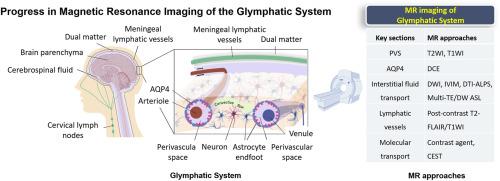肾上腺系统磁共振成像的进展
引用次数: 0
摘要
淋巴系统(GS)是一种新发现的大脑解剖结构。它的发现增进了我们对脑液流动和废物清除路径的了解,并为脑间质(ISF)和脑脊液(CSF)的流动提供了解剖学基础。脑间质通过血管周围空间(PVS)内的正常交换,促进神经细胞产生的代谢废物排出大脑。因此,GS 主要负责清除代谢废物。据观察,GS 活性降低与中枢神经系统疾病有关,如脑小血管疾病(CSVD)和神经退行性疾病。它的活性有望成为诊断疾病和预测预后的指标。本综述介绍了适合临床使用的 GS 相关磁共振成像(MRI)技术,以及该系统在正常和异常状态下的活动差异。通过对前人研究的总结,提出了适合在临床上监测脑部神经系统活动的成像方法,并分析了这些方法对不同脑部疾病的诊断效果。这篇综述旨在为以脑部神经系统为重点的基础研究的临床转化理清思路,并为未来的临床研究提供方向和展望。本文章由计算机程序翻译,如有差异,请以英文原文为准。

Progress in magnetic resonance imaging of the glymphatic system
The glymphatic system (GS) is a newly discovered brain anatomy. Its discovery improves our understanding of brain fluid flow and waste removal paths and provides an anatomical basis for the flow of cerebral interstitial fluid (ISF) and cerebrospinal fluid (CSF). GS occurs through a normal exchange within perivascular space (PVS), facilitating the elimination of metabolic wastes generated by nerve cells from the brain. Therefore, the GS is mainly responsible for the removal of metabolic waste. Reduced GS activity has been observed to be associated with central nervous system disorders such as cerebral small vessel disease (CSVD) and neurodegenerative diseases. Its activity is expected to be an indicator for diagnosing diseases and predicting their prognosis. This review introduces the magnetic resonance imaging (MRI) technology related to the GS suitable for clinical use and the difference in the system's activity in normal and abnormal states. Through a summary of previous research, imaging methods suitable for monitoring the activity of the GS in the clinic were proposed, and their diagnostic effect on different brain disorders was analyzed. This review aims to clarify ideas for the clinical translation of basic research focusing on GS and provide future clinical research directions and perspectives.
求助全文
通过发布文献求助,成功后即可免费获取论文全文。
去求助
来源期刊

Magnetic Resonance Letters
Analytical Chemistry, Spectroscopy, Radiology and Imaging, Biochemistry, Genetics and Molecular Biology (General)
自引率
0.00%
发文量
0
 求助内容:
求助内容: 应助结果提醒方式:
应助结果提醒方式:


